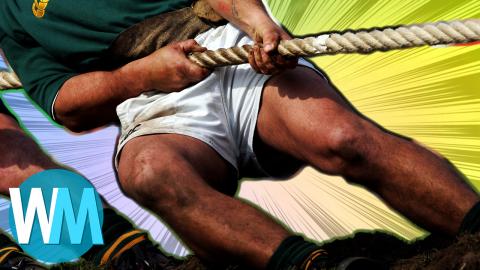Top 10 Bizarre Discontinued Olympic Sports

There have been many sports removed from the Olympics over the years. For all of the popular Olympic sports, there has also been live pigeon shooting, tug of war or solo synchronized swimming – all of which fall into the category of retired Olympic sports. WatchMojo counts down ten bizarre Olympic sports that have been dropped.
Watch on Our YouTube Channel.
Special thanks to our users AaronC and Lloyd Eksteen for suggesting this idea! Check out the voting page at http://WatchMojo.comsuggest/Top%20Ten%20Weird%20Discontinued%20Olympic%20Events
Top 10 Unusual Discontinued Olympic Events
Shaun White Biography: Olympic Snowboarder's Life and Career
You got a gold medal for... what? Welcome to WatchMojo.com and today we’re counting down our picks for the top 10 unusual discontinued Olympic Events. For this list, we’ll be looking at the unusual, wacky, and downright weird events that once held a spot in the Olympic line up. Demonstration events – meaning events that didn’t issue medals – are open for review; however, we will only be looking at sporting events, which means as odd as the idea is, art-based non-sporting events are not up for consideration today.
#10: 2000m Tandem Bicycle Sprint 1906-08; 1920-72
Introduced during the 1906 unofficial Olympic Games - the Intercalated Games - tandem cycling was dropped from the Olympics after 1972. Although a risky, dangerous activity given that it took place on a steeply banked track, evidence suggests the event was dropped simply to help streamline the Olympic schedule. A men’s only event, the Tandem Sprint saw 34 riders from 7 countries take part in the first running - with France taking gold and Great Britain taking silver and bronze. France and Italy led the gold count with 3 each, but Great Britain led the medal count overall at 6.
#9: Skijoring 1928
Only held as a demonstration event during the St. Moritz winter games, skijoring can best be described as dog sledding - but with a horse - or waterskiing on ice with a riderless horse for a boat. Although dogs, horses, or vehicles are all viable options for pulling the skier. Rooted in Sweden and Norway where it was used as a form of military transport, the event was actually dominated by the Swiss who took all three top positions. Skijoring had a home in the Nordic Games from 1901 to 1909 but failed to catch on at the Olympics, and as such hasn’t been seen since February 12, 1928 - the one day on which the event took place.
#8: Singlestick [aka Cudgels] 1904
Depending who you ask, singlesticks was either at its peak or had already become quite passé by 1904. The fact that only three people took part and that it was dropped due to the lack of participation seems to support the notion that the sport had just become old hat. Essentially fencing but with sticks, and Sherlock Holmes’ preferred method of advanced ass kicking, historians now debate whether the singlestick competition seen in 1904 may have actually been a mislabeled bout of cane fighting. In any event, American Albertson Van Zo Post scored gold and William O’Connor walked away with silver. William Grebe was granted bronze, probably more or less just for participating.
#7: Bandy 1952
Resembling a typical game of field hockey but on ice, bandy is basically ball hockey played with football rules. The rink conforms to football field standards, teams have 11 members per side and game play is divided into 45-minute halves; however the ball is closer in size to a tennis ball ... because a football-sized ball would just be ridiculous. A non-medal event, play in Oslo was dominated by Scandinavians with Sweden, Norway, and Finland making up the podium - however, they were also the only teams to compete. All three were tied at 1 win and 1 loss with Sweden being declared the winner based on goals scored.
#6: 200m Swimming Obstacle Event 1900
Only held once - in the currents of the River Seine in Paris - the swimming obstacle event saw competitors swim, climb a pole, climb over some boats, swim under some boats, and swim a bit more. Frederick Lane of Australia took first place having determined the best way to get into the boat was at the stern. Lane won in a time of 2:38.4, which shattered his qualifying time of 3:04. Lane also won a gold medal in the 200m freestyle swim where he was a mere 13 seconds faster than his obstacle race performance.
#5: 100m Running Deer 1908 - 1948
For this event, shooters would have ten 4-second chances to shoot a fake deer target as it made a brisk 75-foot run for a potential maximum score of 80 points. Shooting took place at 110 yards from the target and was divided into single shot and double shot competition. Sweden proved to be the overall medal leader with Oscar Swahn of Sweden winning both the first gold in the single shot event and a bronze in the double shot contest. Later, in the 1920 games and just shy of 73 years of age, Swahn became the oldest person to take part in the Olympics and earned a silver medal for his efforts in the double shot.
#4: Equestrian Vaulting 1920
Also called figure riding or even l’epreuve de voltige, equestrian vaulting is effectively dance-gymnastics on a horse. Here a man would jump on a horse from a standing position, hop down the other side, jump up again, then jump over the horse and perform a few more moves. It’s unknown what the horse thought of all this... Held only once, at the 1920 Games in Antwerp, only France, Belgium, and Sweden took part in the event and all 18 participants were military officers. Belgium took both first and third while France grabbed second. Sweden, meanwhile, completely washed out and took all five bottom spots.
#3: Live Pigeon Shooting 1900
Sparking animal rights campaigns and banned in the United States two years later, live pigeon shooting was held just once at the Olympics and was replaced in later games with very non-living clay pigeon shooting. Almost 400 birds were released into the sky and killed throughout the event. Shooters remained in the “game” until they missed two birds in a row. Belgium’s Leon de Lunden topped the games with 21 kills in the 200 Franc division. His score was actually topped in the 20 Franc event by Donald MacKintosh of Australia, who also tied for third in the 200 Franc competition. As a demo event, no medals were issued; however 20,000 Francs were split among the top 4.
#2: Tug of War 1900 - 1920
5 Inspirational Facts About the Laureus World Sports Awards
The main event at church fairs and company picnics everywhere, Tug-of-War was one of the earliest Olympic events, dating back to the Ancient Games circa 500 BC. Oddly, the game was not without its share of controversy. The 1900 games saw Sweden and Denmark join forces and form a joint team to defeat the French and also earn Sweden its first gold. 1900 also saw the first black Olympian in France’s Constantin Henriquez de Zubiera. The 1908 games saw Great Britain pack the podium, with all three clubs being police officers, but the Liverpool club’s heavily weighted boots drew the ire of the Americans who withdrew in protest. Before we unveil our top pick, here are a few honorable mentions. - Club Swinging / Indian Club Swinging 1904; 1932 - Plunge for Distance 1904 - Motorboating [aka Power Boating or Water Motor Sports] 1908
#1: Solo Synchronized Swimming 1984 - 1992
Debuting at the LA Games in 1984, solo synchronized swimming never failed to raise the question: how can it be synchronized if it’s solo? The activity was based on the fact that the synchronization was actually meant to be to the music and not one’s fellow swimmers. But reduced to one person, the sport looked more like a woman in a swimsuit frolicking in a pool than an organized sporting event. All medalists in the triple S’s history were Japanese, American, and Canadian. In fact, Canadian swimmer Sylvie Frechette gave the sport its only real drama when she was accidentally awarded an 8.7 instead of a 9.7, a slip up that initially cost her the gold. Do you agree with our list? What’s your favorite discontinued Olympic Event? For more silver and gold Top 10s published daily, be sure to subscribe to WatchMojo.com.



